Journal Entries
CW: mental wellness, depression, anxiety, death/loss
Pre-Pandemic
Anxiety. Depression. Mental health. For both of us, these words summed up 2018 and 2019. Talk about a build up to a 2020 climax, right? As foreboding as that sounds, our pre-pandemic worlds confronted us with the need to make space for carework. As you will read in this section, the choices we made and opportunities we had prior to the pandemic ultimately prepared us to persist through the pandemic and to prioritize our mental wellbeing.
In the Fall of 2018, I decided it was time to revisit the possibility that I needed outside help for my mental health. I had managed on my own fairly successfully (what does it mean to be “successful” in this regard?) for about a decade, but it was time to look into other options. Chronic anxiety had taken over my life, and I was noticing the disruptions it caused in my day-to-day life. I didn’t realize that I was losing moments of joy, but, in hindsight, it was because I was in a pretty constant state of fear and panic. My first step in seeking support was to start regular therapy sessions. Around this time, I also found that keeping my hands busy also kept my mind busy. I bought a “your first cross-stitch” kit intended for children at my local crafting store, and I taught myself how to quiet my mind with cross-stitch. The intense focus on counting the stitches in the pattern and creating little X’s was enough to get me out of my head and into my body.

A purple cross stitch hoop with oatmeal colored aida cloth, thread, and needles. The partially finished cross-stitch is an image of Dracula standing between a candelabra and the beginnings of an outline of a coffin.
In February of 2020, almost a year and a half after starting regular therapy sessions, I decided that I would once again take medication to treat my anxiety. Although the panic had subsided a little, my therapist told me I don’t have to keep living this way. I’m not sure why, but that stuck with me, and I decided to talk to my primary care provider about my options. The timing of starting my medication and the disruption of normalcy that came along with COVID-19 in March of 2020 was interesting to say the least. I had the presence of mind to recognize that the medication was playing a role in my handling the disruption relatively well. Or maybe it was that I was so used to operating in a state of high anxiety that when others in the world around me started to panic, it was just my “normal.” Either way, I don’t like change. New situations cause me a lot of anxiety, but in some way, at least at the outset, I just went with it.
So what does this have to do with carework? What does this have to do with my writerly life and my identity as a writer and teacher of writing?
Looking back before the pandemic (this is so strange to think about; time seems to flow differently for me now, and in some ways it feels as though the pandemic stretches much further back for me than March of 2020), I see a person in crisis. I completed my PhD in 2018, but struggled to find a permanent teaching position after graduation. I made it to many final rounds of interviews, but just couldn’t manage to land a job. Colleagues and family told me that it was good experience and that I should be honored to make it that far, but ultimately I questioned my self-worth and my abilities as a scholar and teacher. The feeling of accomplishment for earning my degree began to wane—and was in turn replaced by feelings of hopelessness and doubt.
I was fortunate to be offered a postdoc at my doctoral institution where I was told I would conduct research and run faculty development programs. However, a shift in staffing meant that I was unable to focus much on research, so instead I focused the majority of my time on faculty development. I quickly discovered that sitting at a desk all day and planning programs was not for me. Showing up to work for an 8:00am-5:00pm shift in a windowless office day after day affected my mood. I found myself getting increasingly short with my spouse, losing my focus at work, and spending less time doing things that had once brought me joy like exercising, playing video games, and cooking.
As my mental health deteriorated, I made the decision to once again go on the job market, this time opening myself up to teaching positions in the K-12 system. I had never taught K-12 before, but I knew that in order to be happy, I had to be back in the classroom. Ultimately, I accepted a position in a neighboring county to teach dual enrollment. I had several years of experience teaching dually-enrolled students, and those experiences had been nothing but positive, so I was overjoyed at the thought of teaching in this climate. With this new job came feelings of joy and energy once again. However, as quickly as they came, those feelings fled as I lost someone close to me.
In the late summer of 2019, my Mom passed away. As I sit in front of my screen and ponder what to write about her passing, I am left feeling empty. Perhaps it still feels too raw. She raised me as a single parent after my Dad passed when I was nine. She was my biggest supporter, and she was one of the kindest, most vibrant, and stylish people I have ever met. I miss her very much.
In the fall of 2019, I began my new job as a high school teacher. While I was hired to teach dual enrollment, I was told that they needed me to teach three sections of 9th grade English, one Humanities elective, and one dual enrollment course. Not what I signed up for, but hey, I try to be a team player. Almost immediately, I realized that I was out of my depth. No amount of classroom management teaching college students (dually-enrolled, adult, or otherwise) or faculty could prepare me for the needs of managing a class of thirty-plus 9th graders. The non-stop talking, throwing things, fist fights, and theft wore me down very quickly. I found myself drifting back to a place of fear, doubt, and hopelessness.
Ultimately, I discovered that what I need to feel valued as a teacher and to experience joy in my job is agency. In my Humanities class and in my dual enrollment classes, I had it. The dual enrollment program runs through my current institution, where I taught previously as an adjunct, and they knew my skills and abilities and trusted me to teach my students. Because my Humanities class was an elective and wasn’t governed by state testing, I was left to my own devices. This class in particular brought me the most joy while teaching high school because I had the freedom to explore important topics in the Humanities such as consent and oppression, and a personal favorite, horror fiction (we did an entire unit on monsters and wove into it discussions of oppression and consent in popular stories such as Mary Shelley’s Frankenstein, and it was glorious). For the majority of my course load, 9th Grade Honors English, I had very little agency. That course in particular was crucial for state testing, and the 9th grade English team constantly found ourselves under observation from our high school and from officials in the district. Tension was high, and morale was low. I felt angry at things out of my control such as my Mom’s passing. I felt hopeless that I would ever find a job that brought me joy. I felt anxious about each coming day and what would await me as I stepped into the classroom. I slept very little, and when I did, I didn’t sleep well. I fretted over how staying in this job would affect me, my spouse, and our marriage. I would come home at the end of the day and feel so exhausted that I once again didn’t make time for hobbies, fun, cooking, etc. I knew that I needed out of K-12, but my experiences on the job market in higher ed taught me that I simply wasn’t good enough. I applied to a single job that I knew I would love, but I tried my best to not get my hopes up. And then the pandemic hit.
Pandemic
Space. Personal space. Online space. Safe space. We quickly realized that our pandemic world would be defined and governed by space. For Landon, the move to online learning spaces allowed him to prioritize carework. For Brandy, university mandates forced her to be confined to spaces that peaked her anxiety and took away her agency. As we reflect on the metaphorical idea of "making space" for carework, we are sometimes harshly reminded that our spaces shape our ability to make space for our mental and physical wellbeing.
Although my anxiety was managed by medication, I also found myself with more time on my hands as I no longer had an hour commute to and from campus, which coupled with a decrease in socializing with others outside of my home. In other words, I had more free time, and I didn’t know what to do with myself. I would describe myself as a chronic worker and I am often at a loss when there are no tasks for me to complete. So how do I keep myself occupied and satisfied at home? What would keep me mentally engaged? My job is a teaching position with no time dedicated to research, which means my research and scholarly writing comes in bursts. I knew it wasn’t a time to write, so what to do?
It is worth explaining here that, when the pandemic hit in March 2020, classes were moved to completely remote. I had taught fully online before and felt comfortable and confident with the transition. I also taught fully online during the Fall 2020 semester, although a few faculty began returning to in-person teaching. However, Spring 2021 was different. That semester, I was forced to return to the classroom. I began to experience panic attacks during my commute. On the way to work, I would feel numb and would fight to remain in enough control to drive myself to work without incident. Throughout my day in the classroom, I would again fight to remain in control of my body, until I could finally go home for the day. And then, on the drive home, I again fought to remain in control. Upon returning home, I would take a 45 minute walk and I would walk as fast as I could. There was so much pent up energy that I fought to remain in control of my body all day. I needed a release.
Honestly, I don’t think it was safe to drive myself to and from work, but what choice did I have? This isn’t even considering what I feared I was doing to my body long-term. I was fearful of what it would mean to keep my body in this high-level of anxiety for several hours at a time, day after day. I happened to have a check up with my primary care provider, who ended up altering my medication because he was concerned.
The university insisted that I return to the classroom, and there was no recourse possible at the department level. After enduring this for a few weeks, someone recommended that I seek out accommodations under the Americans with Disabilities Act. I didn’t know that this could cover mental health, but I decided to pursue it and was granted an accommodation for remote work due to anxiety. I spent about six weeks back in the classroom before I was allowed to move remote. It took some time, but the anxiety slowly decreased to a manageable level again. I can distinctly remember telling my spouse the moment I felt joy again, specifically when singing along to music in my car. I couldn’t remember the last time that had happened.
I remember very clearly doing my best to halt the rumor mill among my 9th graders. In early March of 2020, the teachers at my high school hadn’t been given any information about the pandemic. In fact, all we really knew was that there was a virus known as Covid-19, and that it was in the U.S. “We aren’t planning on converting to online teaching after spring break.” “No, we won’t have to take classes all summer.” “Trust me, when we know something, you’ll know something.” As it turned out, the students knew much more than we did, and just as they predicted, we never returned from Spring Break but instead converted to an online platform.
Having taught online for years, I felt confident converting the 9th grade lesson plan entirely to Canvas for remote teaching. I already had my dual enrollment course plotted out on Canvas, and I had been using Canvas in my Humanities course all along to keep students on track. For the first time teaching high school, I felt in my element. More than that, I felt the workplace-anxiety start to ebb. No longer did I dread going to sleep knowing that I would have to wake up at 4:30am and get ready for a day on campus. No longer would I spend the majority of my energy on classroom management. I could focus on honing my lessons and responding to students.
Not too long after we made the transition to an online modality, I heard back from the job I applied for. I got it! I had gotten so used to feeling constantly heavy, burdened by the weight of my perceived self-worth, lack of sleep, anxiety, and hopelessness. I had been dragging the weight of my insecurities and fears while never believing there was an end in sight. Now, I saw the finish line. I slept better. I felt more positive about myself. Because I was teaching online and didn’t have to spend all day on campus, I even took up a new hobby, one very near and dear to my heart: woodworking.
Hobbies
Sawdust. Thread. Family. Hobbies are so much more than the mechanical processes of stitching, gluing, and sanding. Hobbies can connect us to our happiest memories and to the people we care about. In a pandemic world, our hobbies became our carework, and our loved ones, though hundreds of miles away or since passed from this Earth, supported our wellbeing.
I had wanted to buy a sewing machine for quite some time. My grandma has sewn all my life (and much of hers, too!), and other family members have dabbled in other handcrafts as well. I remember my grandma teaching me to sew as a young girl, and I still have (if my memory is correct) what I think is the very first pillowcase I made with her help. At the start of the pandemic, I decided that it was the perfect time to get a sewing machine and start my journey. She had taught me enough of how one worked as a child, and she coached me through my first sewing machine purchase via a phone call because we live several states apart. I was so excited that I made a short TikTok video showing the sewing machine running. I’m not good at TikTok, but it was a great way to test my skills.
Ever since that time, it’s been quite a bit of self-taught work because the pandemic has made in-person visits and teaching difficult. We did manage two visits after being fully vaccinated, and it was so fun to learn alongside her and to share ideas. Below you can see a table runner that we were in the process of making out of scraps.
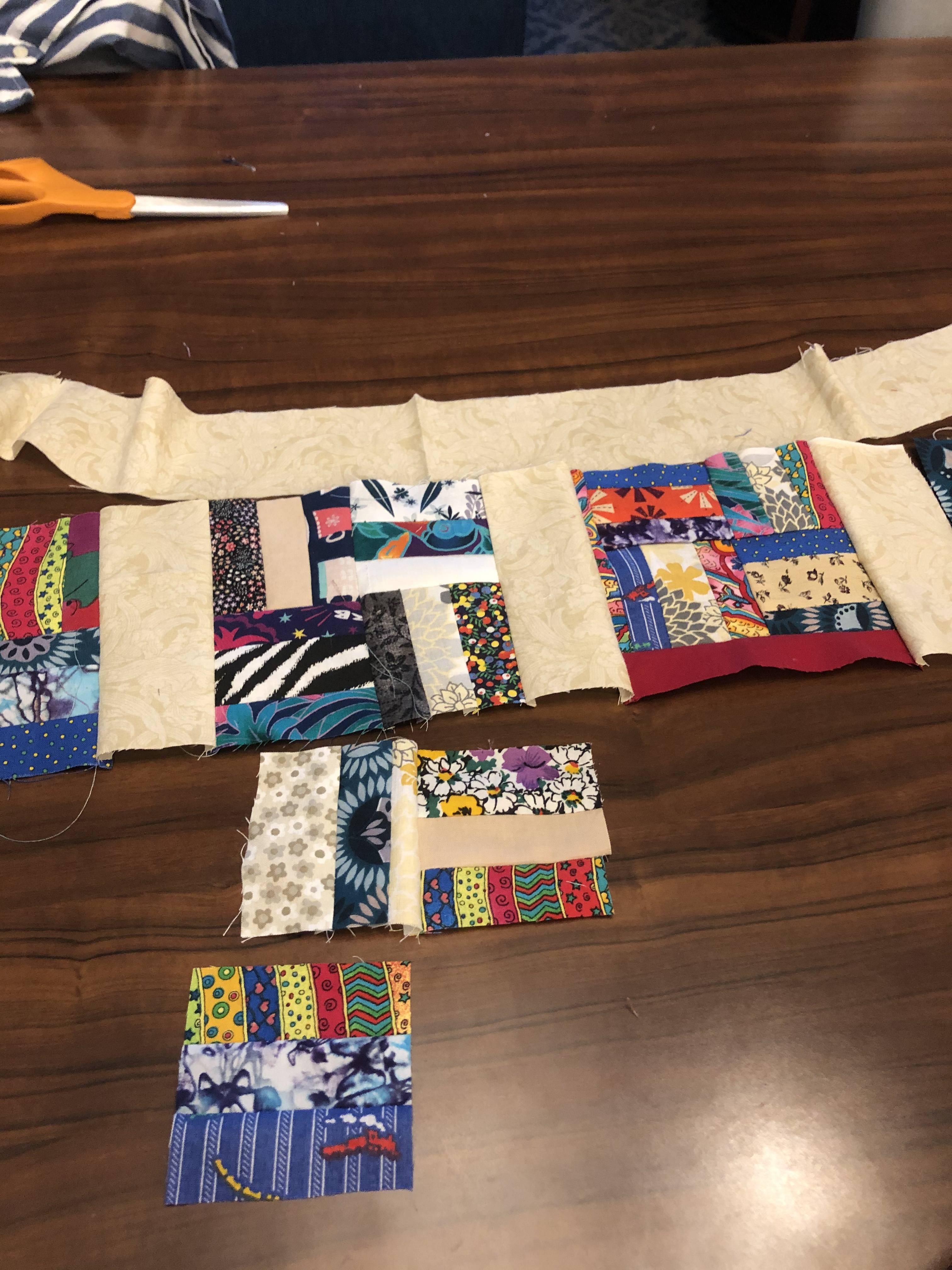
An in-progress photo of a table runner in the making. We sewed together small scraps that varied quite a bit in color and pattern to make a larger square. From there, we sewed together 4 squares to create a larger block. We used long strips of fabric in a neutral beige color to join together the blocks and create visual separation of the blocks.
Being at home more often as an introvert hasn’t been especially challenging in terms of my social life, but it has been challenging mentally. Specifically, I’ve struggled with staying mentally and intellectually engaged, which in turn supports my overall health and wellness. This is where my crafting hobbies come into play.
A lot of reading, writing, and research has gone into this making. I looked up blogs to get pattern ideas. I watched video tutorials. I bought books with patterns in them. I took note of measurements. Sometimes, I literally stitched words into the projects I was making.

Aida cross-stitch with purple, blue, and grey flowers with greenery surrounding text that reads “Reclaiming my time.”
My dad was an excellent woodworker. He would let me join him in his workshop, and I vividly remember the smell and feel of the sawdust on the floor. To this day, no smell brings me more peace and puts a bigger smile on my face than freshly-cut wood and sawdust. Because he passed when I was so young, I have always valued his hobbies as if they are living memories. It is no surprise to me then, that even though I never got to create with my Dad, I have always loved building things like he did. Looking back at multimodal projects I built during grad school, I feel a sense of pride and accomplishment, but I remember very clearly not feeling confident, creative, or "handy" at the time.
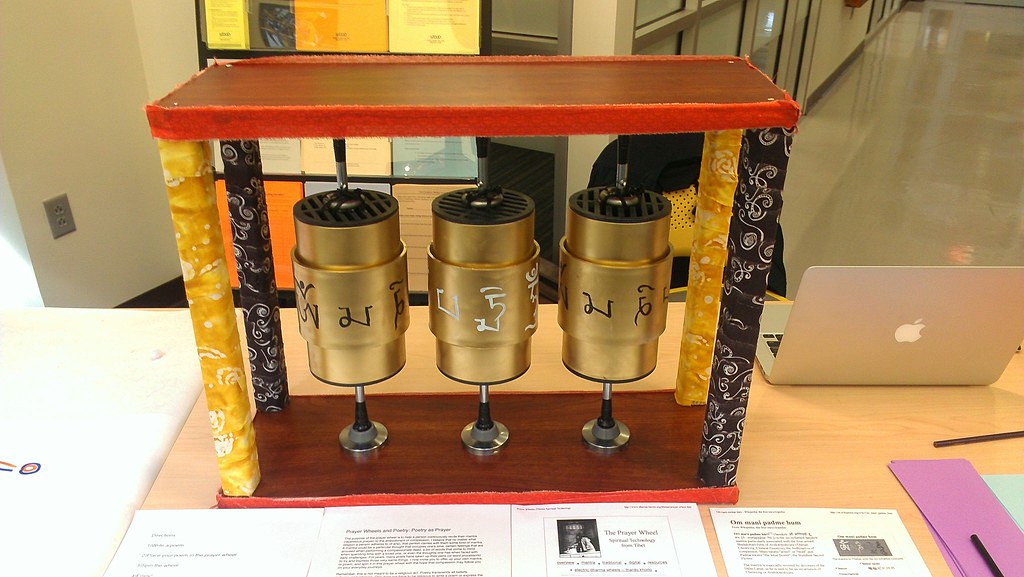
Prayer wheel I built for a Public Poetry Project made from PVC, wood, and fabric.
I teach my Composition I students about multiliteracies, and I tell them that this is an issue of sponsorship (Brandt, 1998). Because of my positive memory of my Dad, I have always loved the idea of creating things, but because I never actually had anyone sit down and teach me how to create, or paint, or build, I never felt like I had the necessary skills and therefore lacked confidence to pursue them. All of this changed after the pandemic hit.
Because I was now in a place where I felt confident teaching online for my high school, because I knew that I would start a new career in the fall, and because I had moved many of my Mom’s possessions down to Florida after her passing (including some of my Dad’s old tools), I was now in a place where I felt that I had the time, tools, and mental bandwidth to take up a new hobby. What better hobby to try than the one my Dad was known for?
When I began this journey, I figured it was best to start small, have plenty of guidance, and work my way up the skill ladder. In fact, my first two projects involved me not making any cuts at all, because my Dad’s old table saw was in a state of disrepair and needed a lot of love before it could cut anything. I bought my first lumber and had it cut to size at my local home center. I took my boards back home and began using the one tool I knew how to use, an old, cheap, battery-operated drill. Here are the end results:
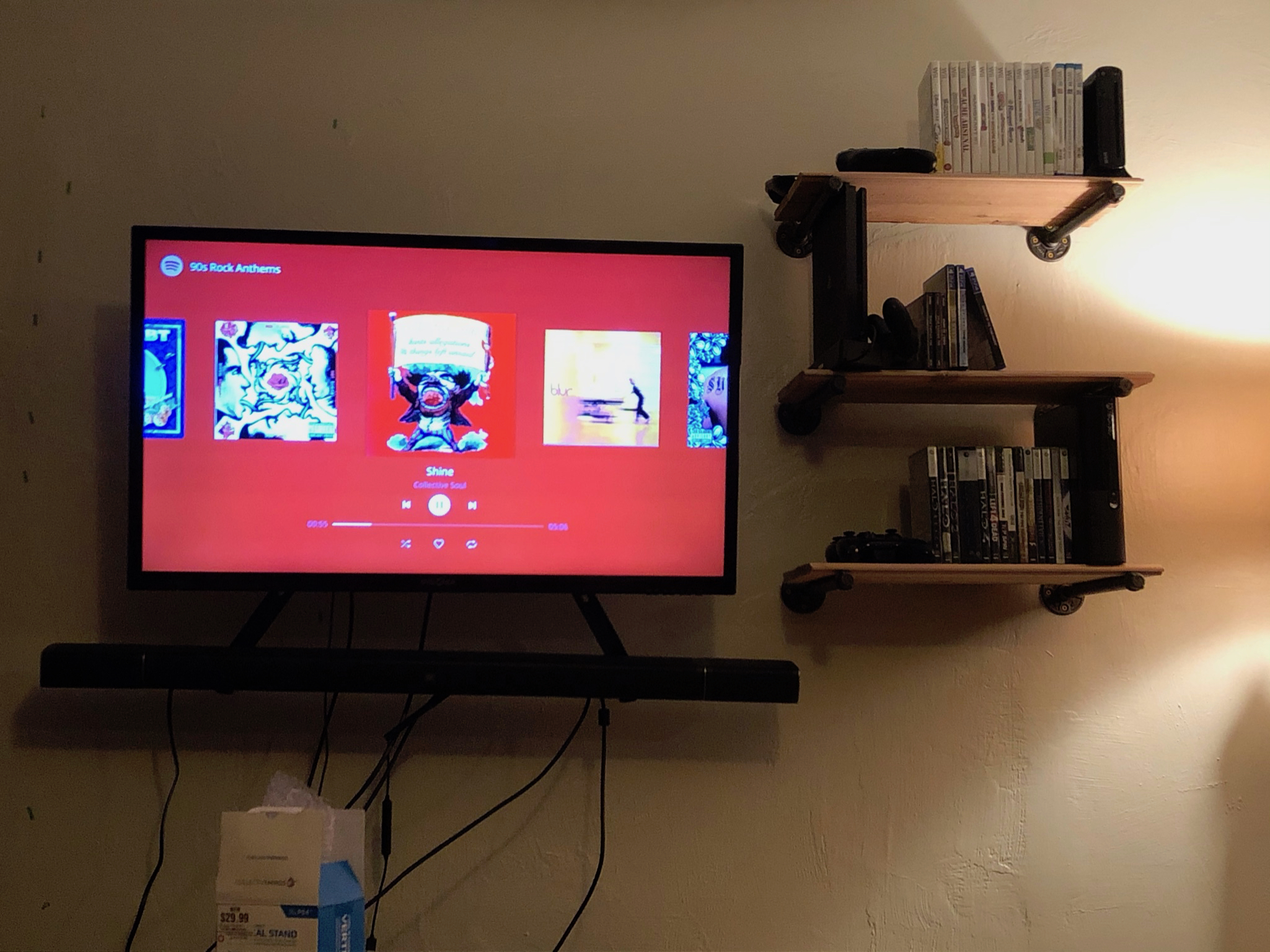
Cedar shelves mounted on steel plumbing pipes holding gaming consoles and video games.

Cedar garden beds arranged in two, adjacent squares, filled with soil and showing sprouting vegetables and herbs.
Looking back, I remember so strongly the feeling of accomplishment at completing these projects. Sure, I didn’t make my own cuts, but I took pieces of wood and metal and created useful and beautiful things with them. I felt connected to my parents in a very visceral way.
Home-Making as Carework
Home. House? Location? Family? We have owned our own house for just over two years now. It’s an older house that has necessitated some updates. Some have been small (a glass shower door, a better WiFi infrastructure), and some have been large (a new roof, a renovated sunroom). For us, home is where you put your love and energy. We share our house with each other and with two cats. Any work we put into our home is an act of love and service for each other. Brandy and I renovated an old television cabinet into a “cat haven” as an act of love for our cats (Kevin and Socks). Landon made a planter for Brandy because she loves flowers, and Brandy made him a cross stitch of an owl (his favorite animal) to hang in his office. Home is love. And carework for our home supports our wellbeing.
Through this process of making, I am caring for my mental wellness and I am caring for my home as I continue to make it my own. Since the pandemic began, I have made:
too many masks to count,
curtains for our home,
family cloth to use with our newly purchased bidet (thanks, toilet paper shortage!),
cloth facial tissues,
a bench cushion,
“un”paper towels,
cloth cotton rounds,
cushions for my cats to sleep on,
a decorative bowl cover for our stand mixer,
cushions to place between stacked pots and pans in the cabinet,
a table runner,
oven mitts,
a halloween themed cross-stitch pattern, and
a feminist cross-stitch pattern reminding me to protect my time.
These projects were, in a large part, aimed at caring for our home, family, and in some ways the environment. I’ve been making efforts to reduce our paper and plastic use in our home, and I made several items to “replace” paper/plastic items (or other kinds of store-bought items). I also made some decorative items for our home, some of which end up supporting not only our home aesthetic and comfort, but our cats too. The image below shows the cushion I made for our “Garden Bench” and one of our cats, Kevin, relaxing on it. He likes to sit there when his dad, Landon, is doing woodworking projects right outside the door in the garage.

A photo of our tuxedo cat, Kevin, relaxing on the garden bench Landon made. On the bench is a cushion made with Halloween fabric that has a combination of skulls, skeleton hands, roses, and spiderwebs on it.
My writerly life during the pandemic is not the kind that I am used to, a scholarly and academic one. Instead, it is one that involves the physical act of making, which I’ve come to see as carework for myself, for my home and family, and for the environment. While I have discovered making quiets my anxiety, I’m now drawn to it even if I’m not feeling particularly anxious in that moment.
Being a first-time homeowner and having a flexible online teaching schedule has allowed me to pursue woodworking. I started with simple but detailed plans, and then worked my way up to more complex projects. I even had the opportunity to build my own workbench using a benchtop that my Dad built years and years ago .

Workbench on castors using plywood, oak, and an old benchtop made by my Dad.
Eventually, as my toolbox expanded, I knew that what was ultimately needed was a proper education in woodworking. For that, I turned to Steve Ramsey, a YouTube woodworking personality whose videos have made woodworking accessible to even the most amateur woodworkers. I signed up for his Weekend Woodworker class and began my proper education. The goal of this class is to help hobbyists spend time in their shops on the weekend and build projects for their home. Each lesson takes place over a Saturday and Sunday (though one is able to access the lessons, videos, and materials at any time and complete projects at their leisure), and ends in a completed project that can be used in one’s home. For example, during week 2, I built a “Harmony Garden Bench”, which my spouse and I used as a sort of mudroom by our garage door, since we lack the space for a proper mudroom. Brandy added to this project by sewing a fun and comfortable cushion for it. Our cat, Kevin, is a big fan.
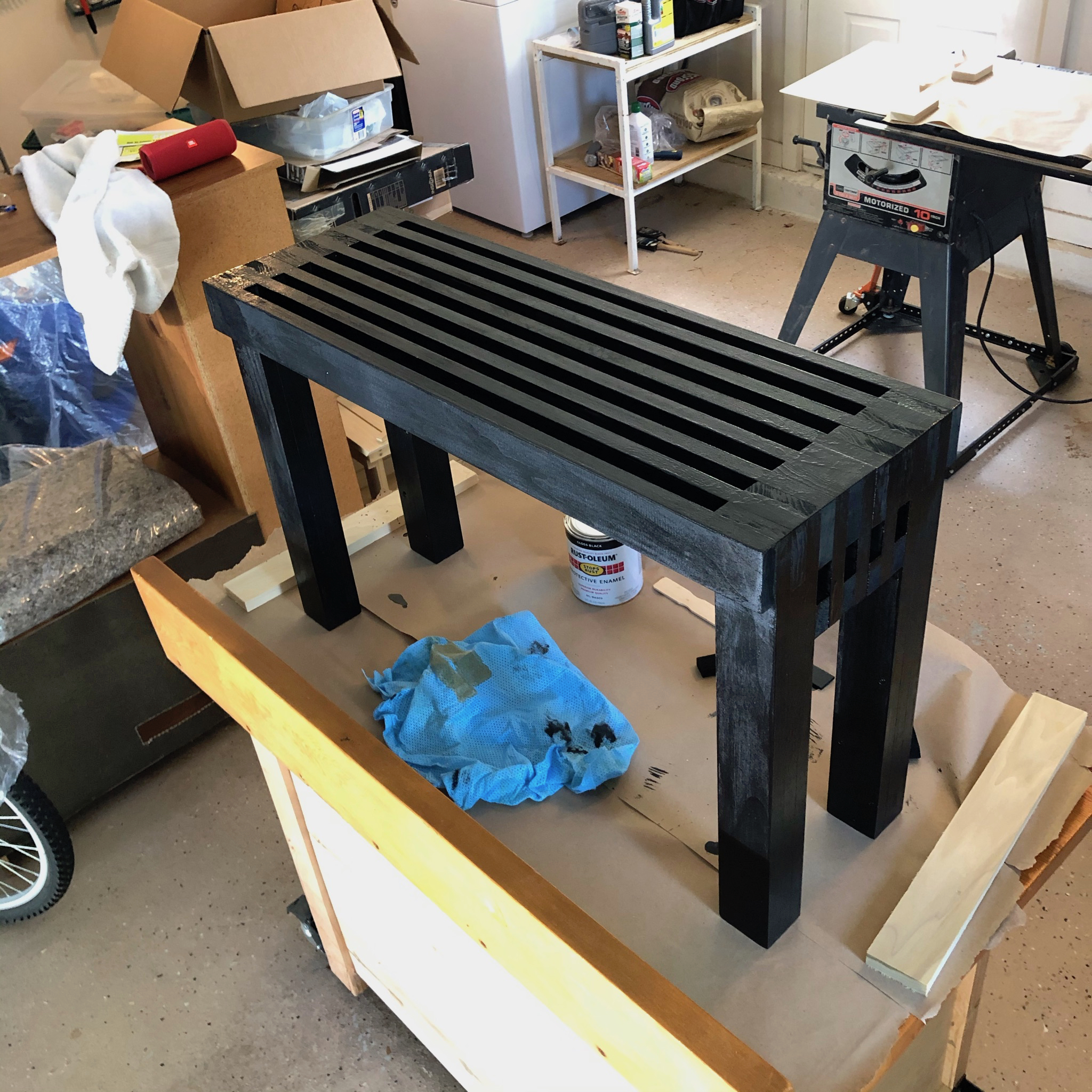
“Harmony Garden Bench” after it received a coat of paint, drying in the garage.
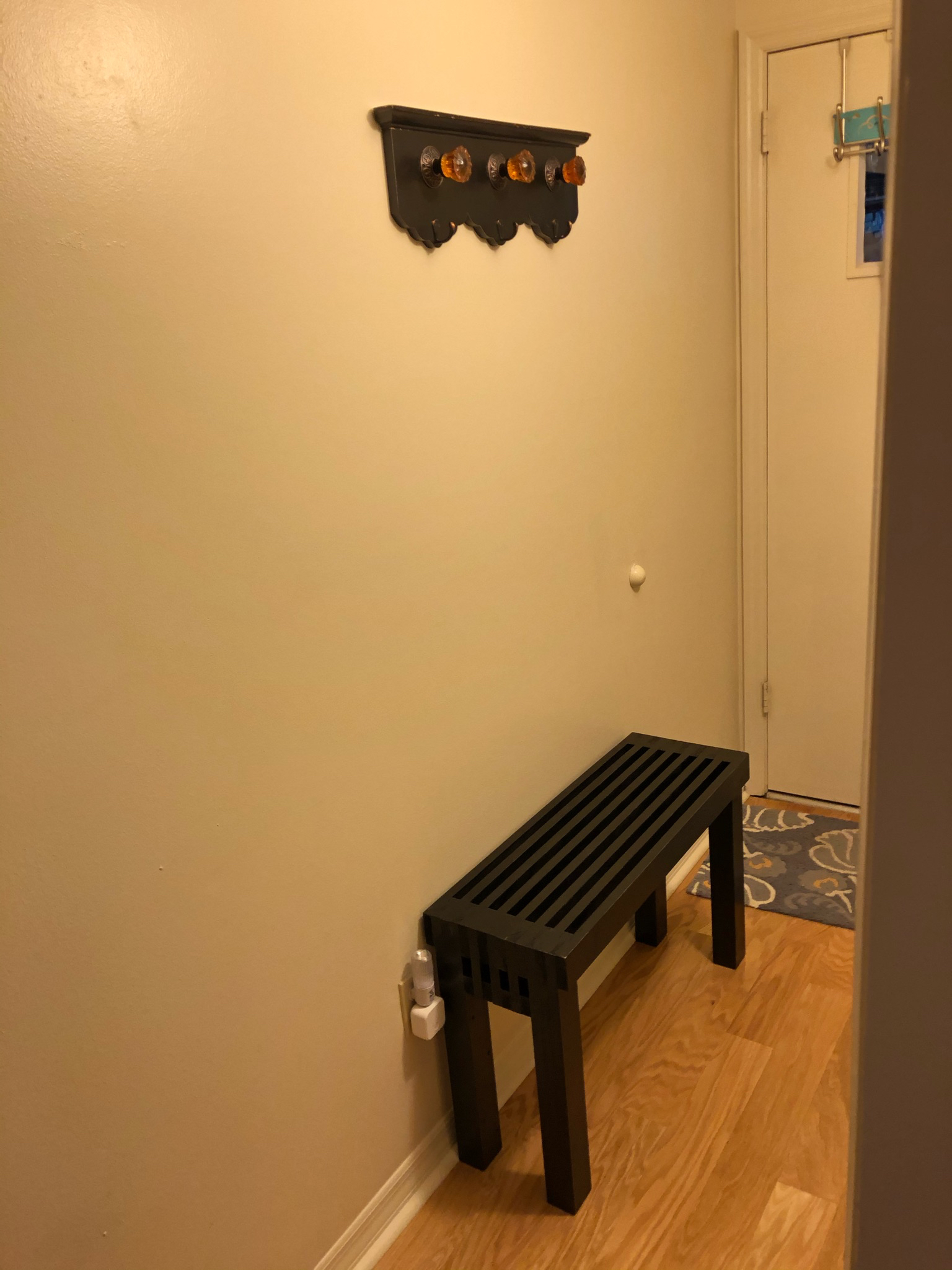
Harmony Garden Bench in “Mudroom”, standing against the wall adjacent to the door leading to the garage.
Taking his class (which one has lifetime access to) shaped my pursuit of woodworking from a few one-off projects into a full-fledged method of caring for my home. Woodworking started as a way to feel connected to my late father, but it became an opportunity to make our very first house healthy and beautiful.
In a sense, woodworking became carework for me, for our home, and also a way to support my spouse. According to Saxbe, Repetti, & Graesch (2011), there is a strong link between post-work stress relief and housework in dual-income married couples. Specifically, they found that husbands experienced greater stress relief when devoting more time to leisure while their wives devoted more time to housework. In our house, we value equity, and we both have a vested interest in supporting our home. While we already had systems in place to make sure we both contribute to our home and feel that we contribute equally (this is something we do check-ins about as household needs evolve), the prospect of home work involving creativity and art was totally new. In other words, leisure and housework converged in an exciting way, and we have both since found great joy in taking time for our hobbies and taking time for our home simultaneously. For example, to improve our bedroom, I built a cabinet to house our laundry baskets and keep them hidden, while Brandy sewed beautiful curtains to replace the ones that came with our house . I topped everything off with a decorative box to hold essential oil for our diffuser. To beautify our yard, Brandy and I turned an old pallet into an herb garden, and I surprised her for her birthday by building a cedar flower planter as she developed her gardening hobby.

Rectangular bedroom cabinet made with plywood, pine, and oak, sitting in front of Brandy’s homemade curtains.

Decorative box made in the shape of a square with a hinged, glass-top lid.

Herb garden made from a discarded wooden pallet from a home center; herbs are mounted in sustainable, plastic planters.

Rectangular cedar planter filled with soil; three flowers bloom from within.
Prior to this realization, I had always thought of carework as self care or caring for others. Certainly, woodworking began very strongly as a means of self care for me. Or rather, I should say that it began once I was in a place where I felt like I could practice self care. Looking back to my journey from 2018 to now, I needed a lot of care. I went to therapy, I tried to take time to myself, but my reality was that I was so deep in the void that I didn’t always have the wherewithal to be a good steward to myself. This is on top of the fact that I wasn’t sleeping well and constantly felt fatigued at home and at work (Garrick et al., 2018). As Trenberth (2005) notes, the relationship between teachers, leisure time/hobbies, and their wellbeing is complex and vastly understudied. Teachers, it seems, aren’t central figures in research on care. Those of us who teach know that care is of the utmost importance for our job performance and for our wellbeing. Woodworking began for me as a venture into an important part of my childhood. It was something that began because I was already sparked with joy and energy. Now it is a means to provide me with joy and energy, but not just as a hobby in and of itself. It is an opportunity to care for my home and my spouse. Home work (as teachers, Brandy and I love the pun on “homework”) is something my spouse and I both value, and every time we create something for our home, we are left feeling a little more proud, and indeed, a little more capable and confident.